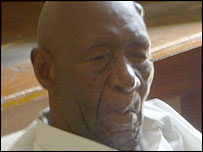|
By Kevin Mwachiro
BBC News, Nairobi
|


Walter Mbotela is proud to live in the same area as his grandfather
|
Walter Mbotela recounts with great emotion the tales of how his grandfather was captured by Arab traders from his birthplace in Nyasaland and shipped away into slavery.
Mr Mbotela senior, along with other slaves, were driven away from their villages and loaded into ships destined for Zanzibar, East Africa's main slave market until 1873.
These captives were however lucky, as after they were purchased and in transit to work in plantations, their ship was intercepted by the British Royal Navy, which was patrolling the Indian Ocean slave routes to enforce the UK ban on the slave trade, adopted in 1807.
For close to 70 years after the abolition, the trade continued to flourish on the East African coast.
"The boat my grandfather and other slaves were sailing on was brought to Mombasa, instead of being taken to other freed slaves settlements in India," Mr Mbotela, a 93-year-old retired journalist recalls.
'History'
Other lucky slaves, aboard cargo ships that were intercepted by the British Navy, found themselves relocated to a freed slave settlement, christened Frere Town.
This area in port city of Mombasa was named after the Sir Bartle Frere, who abolished the Zanzibar slave trade.
Mr Mbotela says many of the slaves freed from Zanzibar came to Frere Town.
The original community was eventually resettled about 30km to the west of Mombasa in the 1930s.
"Many descendants of the freed slaves have since left this area, but I am proud to be among the few who remained and own homes here. It's good to remain in touch with your history," Mr Mbotela says.
Although his origins lie in Nyasaland, which covered parts of what is now Malawi, Zambia, the Democratic Republic of Congo, Burundi and Tanzania, Mr Mbotela says he feels 100% Kenyan, pointing out that he does not speak any of Malawi's languages.
Reminders
The faces of the Frere Town settlement may be gone but its story still lingers among people in Mombasa and a few physical features remain prominent.

This bell was used to warn of slaving ships
|
Still standing tall on the site is the St Emmanuel Anglican Church that was built by the freed slaves.
Also prominent on the site is a bell that was erected and used to sound warnings when Arab slave ships were seen approaching Mombasa Island.
Mombasa residents now fondly refer to the area as Kengeleni, which means bell in the local Swahili language.
There was not much slave-raiding along the Kenyan coast but it was a vital transit point for slaves who were captured further inland, due to its proximity to the main market in Zanzibar.
But Arab slave traders established a smuggling port to the south of Mombasa, in an area now known as Shimoni, meaning the hole in Swahili.
For the traders, the natural limestone caves in Shimoni provided the perfect warehouse for the slaves before they were shipped off to Zanzibar.
The caves, which are now a historical site, are eerie, damp and dark with the ravages of time.
The exit to the sea has silted up and colonies of bats now line the inner chambers of the cave, while lit pathways make for easier access for the many tourists who visit the caves.
Rusted chains and hooks are still embedded into the walls of the caves.


~RS~q~RS~~RS~z~RS~47~RS~)